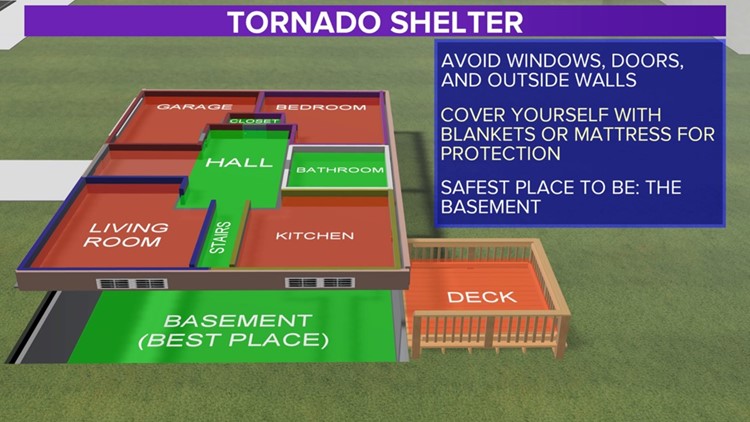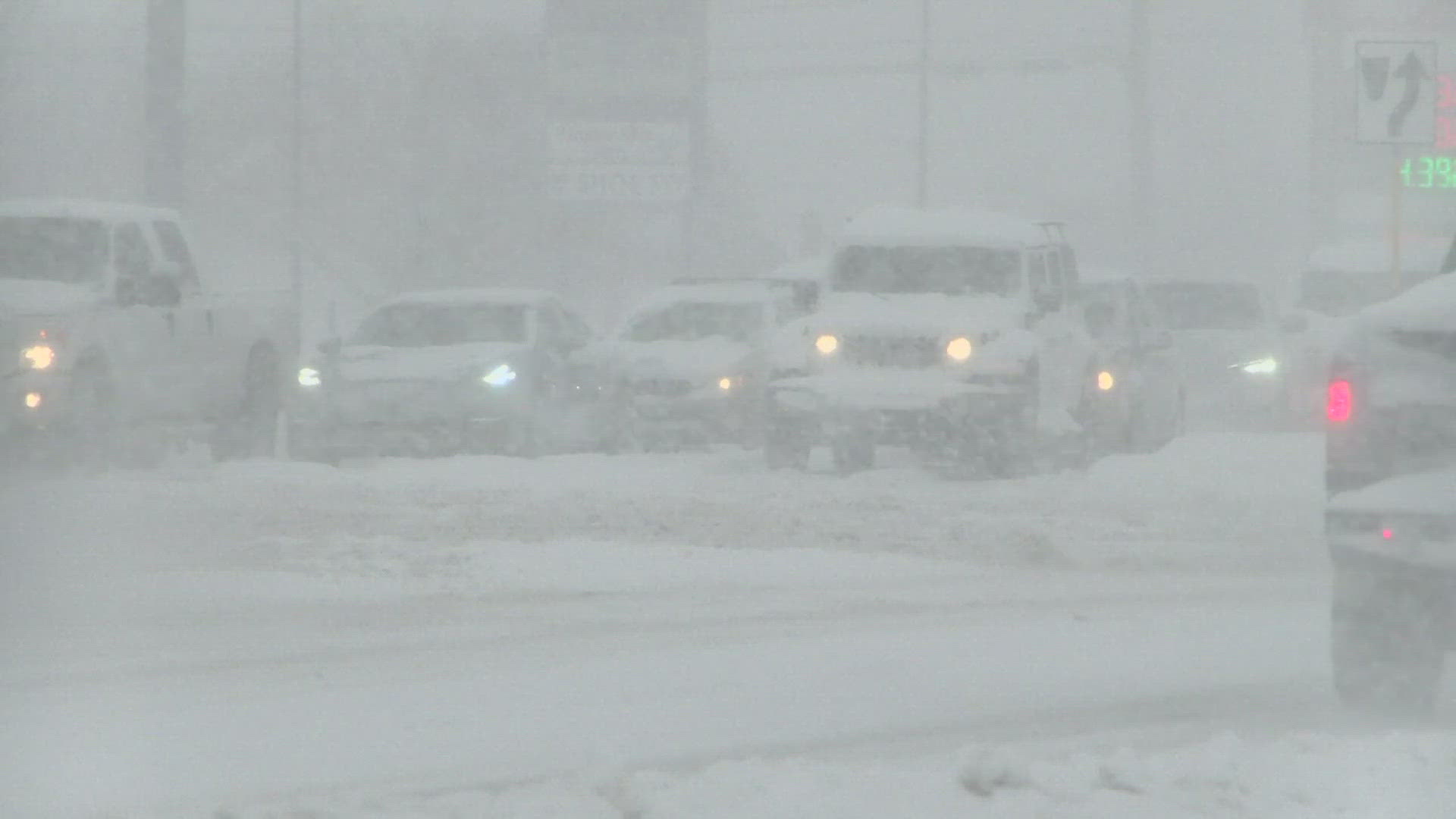KENTUCKY, USA — Tornadoes are one of the most unpredictable natural disasters. There is also a lot of misinformation attached to tornadoes, which can put you or your family in harms way.
We compiled a list of safety tips and facts about tornadoes. These safety tips are things you and your family can do before, during and after a tornado.
The first thing you should know is the difference between a tornado WATCH and a tornado WARNING.
Tornado watch vs warning
Tornado Watch: Be Prepared! Tornadoes are possible in and near the watch area. Review and discuss your emergency plans and check supplies and your safe room. Be ready to act quickly if a warning is issued or you suspect a tornado is approaching. Acting early helps to save lives! Watches are issued by the Storm Prediction Center for counties where tornadoes may occur. The watch area is typically large, covering numerous counties or even states.
Tornado Warning: Take Action! A tornado has been sighted or indicated by weather radar. There is imminent danger to life and property. Move to an interior room on the lowest floor of a sturdy building. Avoid windows. If in a mobile home, a vehicle, or outdoors, move to the closest substantial shelter and protect yourself from flying debris. Warnings are issued by your local forecast office. Warnings typically encompass a much smaller area (around the size of a city or small county) that may be impacted by a tornado identified by a forecaster on radar or by a trained spotter/law enforcement who is watching the storm.
Safety Tips: BEFORE A TORNADO
- Be alert to changing weather conditions.
- Download the WHAS11 App and turn on your notifications
- Look for approaching storms
- If you aren't near at TV Listen to NOAA Weather Radio, watch WHAS11 newscasts online or our App for the latest information.
- Pick a safe room - a basement, storm cellar or interior room on the lowest floor with no windows.
- Move items inside that could be picked up by the wind such as lawn furniture, trash cans and hanging plants.
- Watch for tornado danger signs such as dark, often greenish clouds, a wall cloud or cloud of debris, large hail, a roaring noise or funnel cloud.
Safety Tips: DURING A TORNADO
- If you are under a tornado warning, seek shelter immediately.
- Get indoors to a pre-designated shelter area such as a basement, storm cellar or the lowest building level. If there is no basement, go to the center of an interior room on the lowest level (closet, interior hallway) away from corners, windows, doors and outside walls.
- Shutter windows and outside doors.
- If in a vehicle, trailer or mobile home, get out immediately and go to the lowest floor of a sturdy, nearby building or storm shelter.
- If unable to get indoors, lie flat in a nearby ditch or depression and cover your head with your hands. Be aware of potential flooding and flying debris.
- Never try to outrun a tornado in your vehicle. Instead, leave the vehicle immediately for safe shelter.
- The safest place to be is an underground shelter, basement, or safe room.
- If no underground shelter or safe room is available, a small, windowless interior room or hallway on the lowest level of a sturdy building is the safest alternative.
- Mobile homes are not safe during tornadoes. Abandon mobile homes and go to the nearest sturdy building or shelter immediately.
- If you are caught outdoors, seek shelter in a basement, shelter or sturdy building. If you cannot quickly walk to a shelter: Immediately get into a vehicle, buckle your seat belt and try to drive to the closest sturdy shelter.
- If flying debris occurs while you are driving, pull over and park. Now you have the following options as a last resort: Stay in your vehicle with the seat belt on. Put your head down below the windows, covering with your hands and a blanket if possible.
- If you can safely get noticeably lower than the level of the roadway, exit your car, and lie in that area, covering your head with your hands.
- Your choice should be driven by your specific circumstances
What to do based on where you are:
House/Stand-alone building:
- Get to the lowest level possible
- Go to an area with as many walls between you as possible
- Get in a bathtub or interior closet
Mobile Home:
- Get out of the mobile home and get in a sturdy building if possible
- Get out of the mobile home and hunker in a ditch
- If no ditch or building is nearby, plan ahead and get to a sturdy building ahead of time
Apartment:
- Get to the lowest level (go to a neighbor's apartment on the first floor)
- Regardless of what floor you're on, get in a bathtub or interior closet
- If you are on a higher level and can't get to a lower apartment, hunker down in the breezeway of the apartment building
Car:
- If possible, pull over, park, get inside a building and out of the storm
- If you have to stay in your car, try to find a ditch to park in and use your emergency brake
- DO NOT park under a bridge or overpass
Miscellaneous Tips for Keeping Safe in a Tornado:
- Cover yourself with a mattress, sleeping bags, or pillows
- Wear a helmet to protect your head
- Hunker down as much as possible
TORNADO FACT OR FICTION
FICTION: Lakes, rivers, and mountains protect areas from tornadoes.
FACT: No geographic location is safe from tornadoes. A tornado near Yellowstone National Park left a path of destruction up and down a 10,000-foot mountain.
FICTION: A tornado causes buildings to “explode” as the tornado passes overhead.
FACT: Violent winds and debris slamming into buildings cause the most structural damage.
FICTION: Open windows before a tornado approaches to equalize pressure and minimize damage.
FACT: Virtually all buildings leak. Leave the windows closed. Take shelter immediately. An underground shelter, basement or safe room are the safest places. If none of those options are available, go to a windowless interior room or hallway.
FICTION: Highway overpasses provide safe shelter from tornadoes.
FACT: The area under a highway overpass is very dangerous in a tornado. If you are in a vehicle, you should immediately seek shelter in a sturdy building. As a last resort, you can either: stay in the car with the seat belt on. Put your head down below the windows, covering with your hands and a blanket if possible, OR if you can safely get noticeably lower than the level of the roadway, exit your car and lie in that area, covering your head with your hands. Your choice should be driven by your specific circumstances.
FICTION: It is safe to take shelter in the bathroom, hallway, or closet of a mobile home.
FACT: Mobile homes are not safe during tornadoes! Abandon your mobile home to seek shelter in a sturdy building immediately. If you live in a mobile home, ensure you have a plan in place that identifies the closest sturdy buildings.



